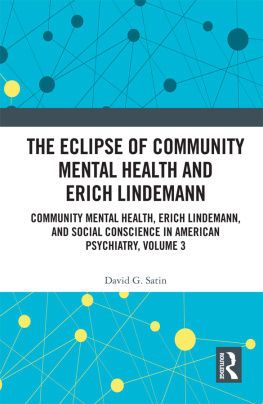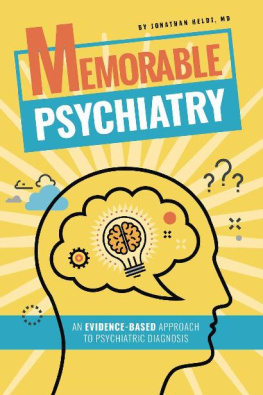The Eclipse of Community Mental Health and Erich Lindemann
These volumes make new contributions to the history of psychiatry and society in three ways: First, they propose a theory of values and ideology influencing the evolution of psychiatry and society in recurring cycles and survey the history of psychiatry in recent centuries in light of this theory. Second, they review the waxing, prominence, and waning of community mental health as an example of a segment of this cyclical history of psychiatry. Third, they provide the first biography of Erich Lindemann, one of the founders of social and community psychiatry, and explore the interaction of the prominent contributor with the historical environment and the influence this has on both. We return to the issue of values and ideologies as influences on psychiatry, whether or not it is accepted as professionally proper. This is intended to stimulate self-reflection and the acceptance of the values sources of ideology, their effect on professional practice, and the effect of values-based ideology on the community in which psychiatry practices. The books will be of interest to psychiatric teachers and practitioners, health planners, and socially responsible citizens.
David G. Satin is a board-certified psychiatrist who has trained at the Massachusetts General and McLean Hospitals, has been Assistant Professor of Psychiatry at Harvard Medical School, where he also obtained his MD and taught gerontology and the history of psychiatry, and has had a clinical practice in adult and geriatric psychiatry.
The Eclipse of Community Mental Health and Erich Lindemann
Community Mental Health, Erich Lindemann, and Social Conscience in American Psychiatry, Volume 3
David G. Satin

First published 2021
by Routledge
52 Vanderbilt Avenue, New York, NY 10017
and by Routledge
2 Park Square, Milton Park, Abingdon, Oxon, OX14 4RN
Routledge is an imprint of the Taylor & Francis Group, an informa business
2021 David G. Satin
The right of David G. Satin to be identified as author of this work has been asserted in accordance with sections 77 and 78 of the Copyright, Designs and Patents Act 1988.
All rights reserved. No part of this book may be reprinted or reproduced or utilised in any form or by any electronic, mechanical, or other means, now known or hereafter invented, including photocopying and recording, or in any information storage or retrieval system, without permission in writing from the publishers.
Trademark notice: Product or corporate names may be trademarks or registered trademarks, and are used only for identification and explanation without intent to infringe.
Library of Congress Cataloging-in-Publication Data
Names: Satin, David G., author.
Title: Community mental health, Erich Lindemann, and social conscience in American psychiatry / David G. Satin.
Description: New York, NY : Routledge, 2021. | Includes bibliographical references and indexes.
Identifiers: LCCN 2020026022 (print) | LCCN 2020026023 (ebook) | ISBN 9780429331350 (v. 1 ; ebook) | ISBN 9781000169805 (v. 1 ; adobe pdf) | ISBN 9781000169812 (v. 1 ; mobi) | ISBN 9781000169829 (v. 1 ; epub) | ISBN 9780429331374 (v. 2 ; ebook) | ISBN 9781000169867 (v. 2 ; adobe pdf) | ISBN 9781000169881 (v. 2 ; mobi) | ISBN 9781000169904 (v. 2 ; epub) | ISBN 9780429331367 (v. 3 ; ebook) | ISBN 9781000171280 (v. 3 ; adobe pdf) | ISBN 9781000171273 (v. 3 ; mobi) | ISBN 9781000171297 (v. 3 ; epub) | ISBN 9780367354336 (v. 1 ; hardcover) | ISBN 9780367354374 (v. 2 ; hardcover) | ISBN 9780367354350 (v. 3 ; hardcover)
Subjects: LCSH: Social psychiatry. | Community psychiatry. | Mental health services.
Classification: LCC RC455 (ebook) | LCC RC455 .S197 2021 (print) | DDC 362.2dc23
LC record available at https://lccn.loc.gov/2020026022
ISBN: 978-0-367-35435-0 (hbk)
ISBN: 978-0-429-33136-7 (ebk)
Typeset in Sabon
by Apex CoVantage, LLC
This history is dedicated to those who created it: the people who raised and struggled with issues of social influences on mental health, the place of social responsibility in mental health professional practice, and the social conscience of society. Committed and thoughtful people took different approaches on these questions but confronted them seriously. Sometimes this brought fulfillment, sometimes despair. Often it took courage; sometimes this resulted in professional and personal injury. Such is the fate of committed people in the historical clash of values. This record and interpretation is especially dedicated to those who unearthed for the record their experiences, memories, and insightssometimes with painto teach their successors about this endeavor. We trust it has been worth their efforts:
All of us bear witness to the dissolution of our piece of creation. Only the novelist can restore to us, in the miracle of ink that pours itself like blood onto paper, the lineaments of our lost worlds, alive.
Note
. Rosen, Norma, My Son, the Novelist, LIVES column, The New York Times Magazine, 8/3/1997, p. 60

Contents
Guide
One of the pitfalls of the celebration of history is presentismthe self-centered belief that current values and perspectives are the only or highest in history. Oliver Wendell Holmes tartly observed: Much, therefore, which is now very commonly considered to be the result of experience, will be recognized in the next, or in some succeeding generation, as no such result at all, but as a foregone conclusion, based on some prevalent belief or fashion of the time.
Social history has a tradition of tracing historical movements through outstanding figures, the individuals exemplifying as much as determining the movements. Erich Lindemanns life1900 to 1974was contemporaneous with the origins of and developments in the community mental health (CMH) movement. He was involved in many important CMH activities and with important participants, and he contributed to and influenced CMH in important ways, both as a leader of its admirers and as a target of its critics. His personal development, the social movements and academic developments around him, the education to which he was exposed and which he chose, the sequence of his professional development, and the responsespositive and negative which he received, paralleled at least the health promotion and illness prevention branch of CMH. We see in his person the development of the values and ideology that were mirrored in that branch and its conflict with other psychiatric ideologies. For these reasons, he provides a useful microcosm of the history of CMH. In addition, there has never been a comprehensive biography of this important contributor to CMH and psychiatry, so that people develop their opinions of him based on only reports or fragments of his thinking and activities. A more complete understanding of the man will make him and his place in psychiatry more comprehensible.
Most emphatically this is not a work of hagiography. We subscribe to Iago Galdstons dual cautions:
Medical history as it has been written during the past 100 years manifestly suffers from two corrupting biases, progressivism and hero worship











